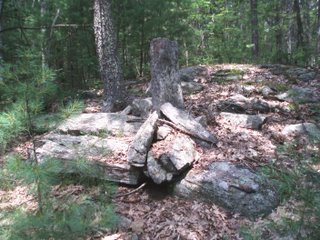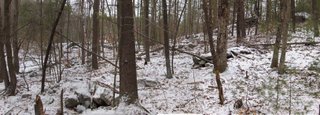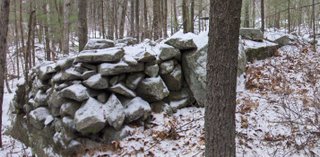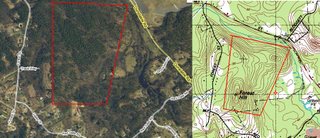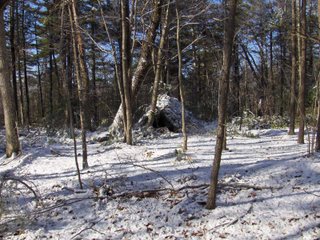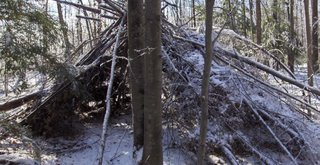 I am allowing myself to make public the location of this site following the guidelines that it has already been destroyed and is in plain site anyway. However if you visit, try not to make a path to the site.
I am allowing myself to make public the location of this site following the guidelines that it has already been destroyed and is in plain site anyway. However if you visit, try not to make a path to the site.I visited this place a few weeks ago (see here) and I again parked on Concord Rd just left of the first "S" in "SSF" on the map fragment. At this point, you can see a couple of rock piles next to the road. From there I walked south east and downhill till I crossed the main dirt road through there. There was a stone wall parallel to the road and, downhill beyond it, what looked like an isolated bit of wall by itself - possibly a rock pile. When I went down to take a closer, sure enough, it was a pile.
 We are at the edge of the conservation land and you can see the houses in the background. The view is roughly to the south. There were three of four piles like this, badly damaged, on a small knoll, nestled in a little bend in the brook. It was a place where you could hear the water gurgling in the brook (see here)..
We are at the edge of the conservation land and you can see the houses in the background. The view is roughly to the south. There were three of four piles like this, badly damaged, on a small knoll, nestled in a little bend in the brook. It was a place where you could hear the water gurgling in the brook (see here)..
 As you can see, these would have been reasonably large piles made from larger rocks about 10-20 inches in diameter.
As you can see, these would have been reasonably large piles made from larger rocks about 10-20 inches in diameter. There was one little wedged split:
There was one little wedged split: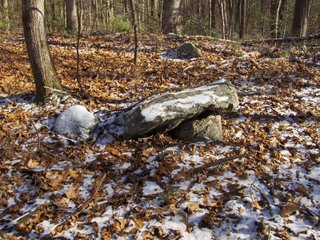 There were also a number of things so badly damaged and running together that I could not make out any part of what the structure was before.
There were also a number of things so badly damaged and running together that I could not make out any part of what the structure was before. I have a number of other pictures from this site but they do not seem to tell much.
I have a number of other pictures from this site but they do not seem to tell much. At some point there should be an accounting for the different proportions of rock piles at different sites. Here the piles are -so- big with component rocks on the average -so- big. And these proportions are typical of rock piles found from -here- to -here-. Also, if we add in the metric of pile "half life" [which I wrote about earlier but I cannot find the link for], we can imagine a quantitative study of sites even though they are as badly damaged as this one. In fact when so little is left of a site, it sheds a harsh light on what is left to study: counting the rocks, counting the piles, measuring the rocks, examining the topography, cataloging the locations.
At some point there should be an accounting for the different proportions of rock piles at different sites. Here the piles are -so- big with component rocks on the average -so- big. And these proportions are typical of rock piles found from -here- to -here-. Also, if we add in the metric of pile "half life" [which I wrote about earlier but I cannot find the link for], we can imagine a quantitative study of sites even though they are as badly damaged as this one. In fact when so little is left of a site, it sheds a harsh light on what is left to study: counting the rocks, counting the piles, measuring the rocks, examining the topography, cataloging the locations.



